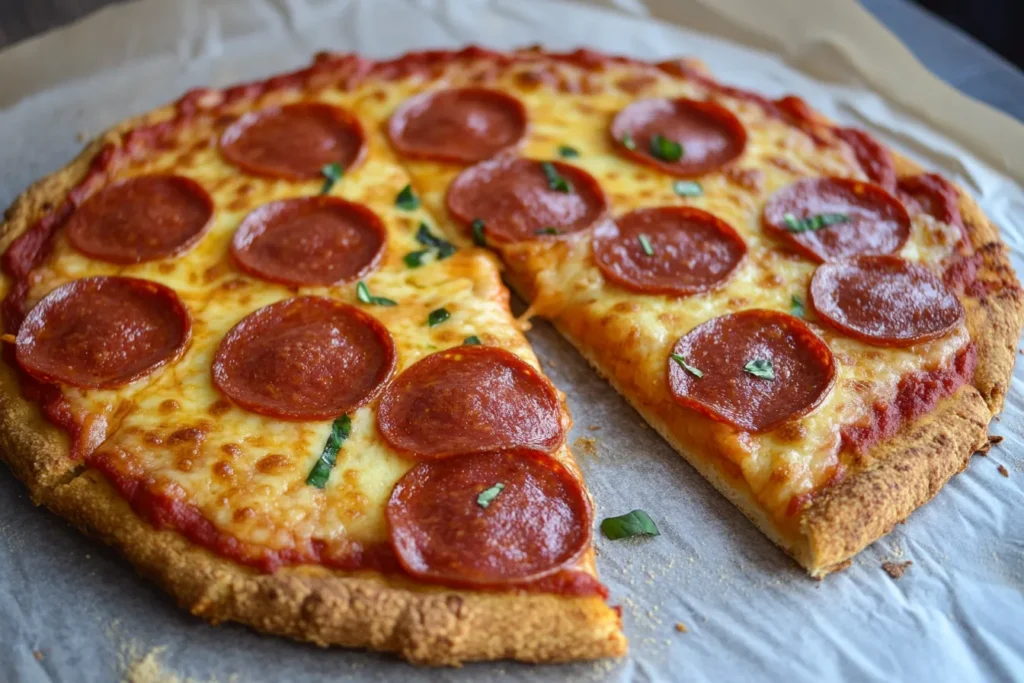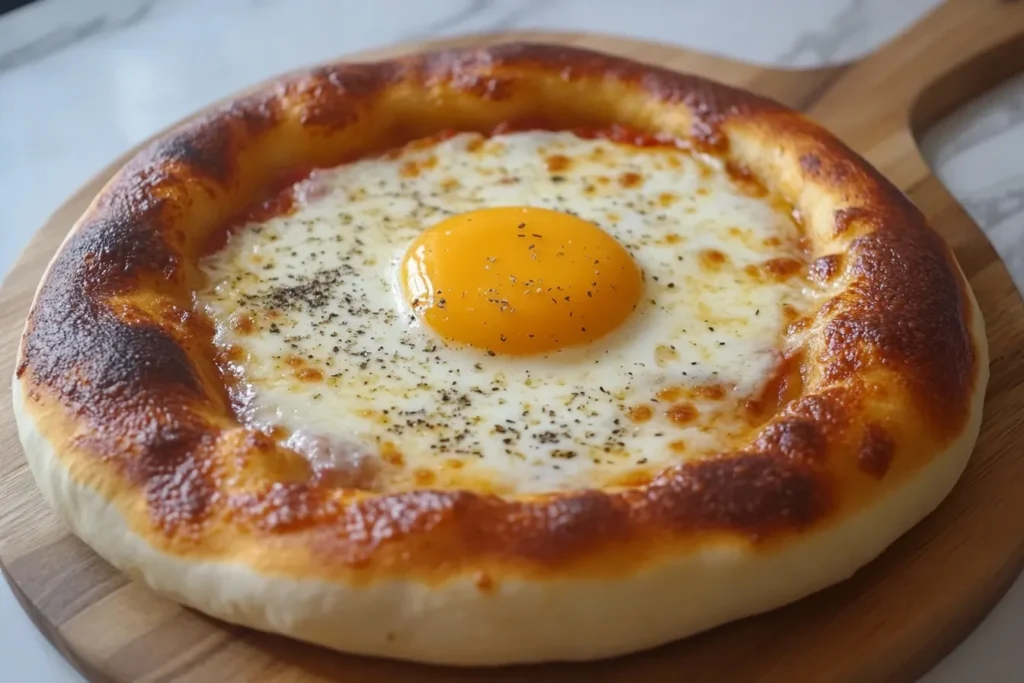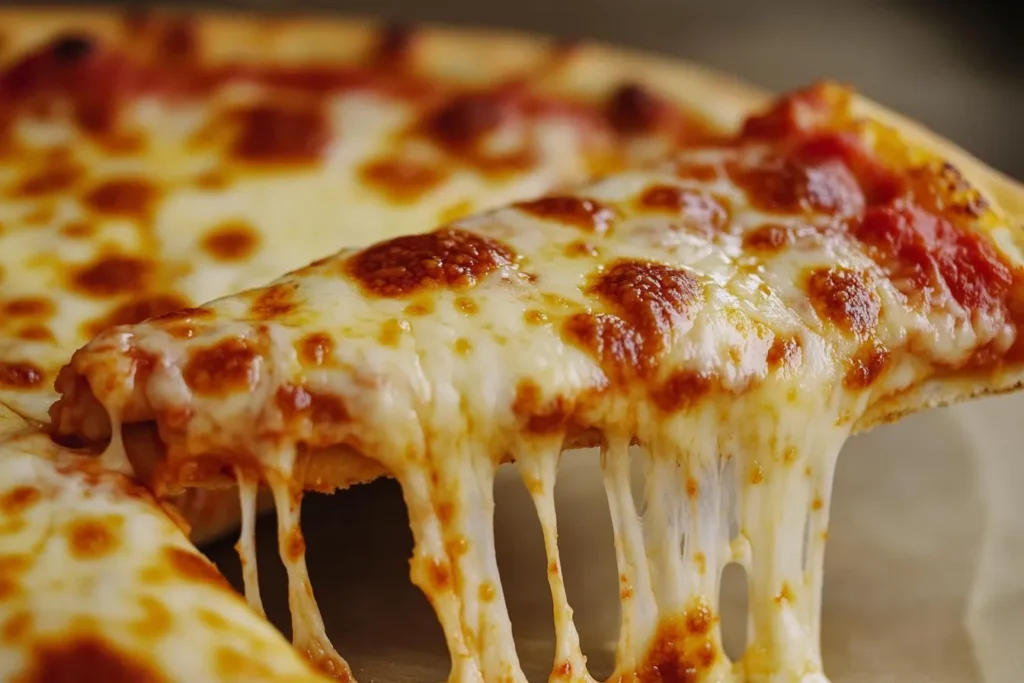Have you ever craved pizza but felt limited by gluten-free options that just don’t hit the mark? You’re not alone. Whether you’re navigating celiac disease, gluten intolerance, or simply exploring healthier choices, finding a gluten-free pizza that’s as satisfying as the classic can feel like an impossible task. But it doesn’t have to be! Imagine enjoying a pizza with a perfectly crisp crust, rich flavors, and endless topping possibilities—all without worrying about gluten. This guide is here to show you how to make or find gluten-free pizza that’s so good, you won’t even miss the wheat. Let’s get started on your journey to pizza perfection!
List Of Contents
What Is Gluten?
Gluten is a protein found in grains like wheat, barley, and rye. It serves as a binder, providing elasticity to the dough and aiding in its rising process. When combined with water, gluten forms a network of proteins that trap air, resulting in a chewy and structured texture in baked goods. check out more recipes here.

Why Choose Gluten-Free Pizza?
Switching to gluten-free pizza is not just about health conditions. Many people opt for this option due to dietary trends or a belief that it’s healthier and lighter on the stomach. Here’s why it’s worth considering:
- Health Benefits: For individuals with celiac disease or gluten intolerance, avoiding gluten prevents inflammation, bloating, and gastrointestinal discomfort.
- Inclusive Dining: A gluten-free option ensures that friends and family with specific dietary needs can enjoy a universally loved meal together.
- Variety of Flavors: Gluten-free pizzas often include unique ingredients like almond flour or cauliflower crusts, introducing diverse flavors and textures.
For those with gluten sensitivity, celiac disease, or wheat allergies, consuming gluten can cause digestive issues, fatigue, and other health problems. Consequently, the demand for gluten-free alternatives has grown, reshaping the culinary landscape. check out more recipes here.
Overview of Gluten-Free Pizza Ingredients
Creating the perfect gluten-free pizza requires rethinking traditional ingredients. Each component is carefully selected to replicate the texture, flavor, and structure of a classic pizza while remaining gluten-free. check out more recipes here.
Gluten-Free Flours
The foundation of gluten-free pizza is its flour, with various alternatives available:
- Almond Flour: Known for its nutty flavor and dense texture.
- Rice Flour: A lighter option often combined with other flours for better structure.
- Chickpea Flour: Adds a protein boost and a slightly nutty taste.
Binders and Stabilizers
Since gluten provides elasticity, gluten-free recipes rely on binders to mimic that property:
- Xanthan Gum: A popular stabilizer that helps maintain the dough’s structure.
- Guar Gum: Another thickening agent that enhances elasticity.
Yeast or Leavening Agents
To achieve a fluffy crust, yeast or baking powder is essential. These ingredients produce carbon dioxide, helping the dough rise and creating an airy texture. check out more recipes here.
Types of Gluten-Free Pizza Crusts
The crust is the heart of any pizza, and gluten-free options are no exception. Here’s a breakdown of the most popular types:
Traditional Flour Alternatives
Flours like almond, rice, or oat create a classic pizza crust. These are often combined with starches such as tapioca or potato for a cohesive dough that mimics traditional wheat-based crusts. check out more recipes here.
Vegetable-Based Crusts
Vegetables like cauliflower, zucchini, and sweet potatoes are transformed into pizza crusts. These are:
- Low in carbs.
- High in nutrients.
- Great for those following paleo or keto diets.
Pre-Made Gluten-Free Pizza Mixes
For convenience, pre-made mixes simplify the process. They often contain a blend of gluten-free flours, starches, and binders, reducing prep time while ensuring consistent results.
Core Ingredients for Gluten-Free Pizza
Crafting a gluten-free pizza that matches the quality of a wheat-based one involves knowing the right ingredients to use. From choosing the best flours to finding suitable binders, each component plays a crucial role in achieving the perfect crust and overall flavor.
Popular Gluten-Free Flour Choices
The type of flour plays a crucial role in shaping the texture, flavor, and flexibility of gluten-free pizza dough. Let’s explore the most popular options:
Rice Flour
Rice flour is one of the most commonly used gluten-free flours due to its neutral flavor and versatility. It serves as an excellent base when combined with other flours and starches.
- Benefits:
- Lightweight texture.
- Mild flavor that complements any toppings.
- Tips: Blend with starches such as tapioca or potato to enhance elasticity.
Almond Flour
Almond flour adds a unique, nutty flavor and a dense texture to pizza crusts. Rich in protein and healthy fats, it’s an excellent option for keto-friendly recipes.
- Benefits:
- Rich, buttery flavor.
- Excellent for low-carb diets.
- Tips: Pair with eggs or xanthan gum for better binding.
Chickpea Flour
Chickpea flour (also called gram flour) is a protein-rich option with a slightly nutty taste. It’s ideal for creating doughs with more structure.
- Benefits:
- High in protein and fiber.
- Adds a subtle earthy flavor.
- Tips: Use sparingly or mix with milder flours like rice to balance the taste.
Additional Ingredients for Texture and Taste
To replicate the elasticity and chewiness of traditional pizza, additional ingredients like binders and starches are essential.

Xanthan Gum and Guar Gum
These ingredients replace gluten’s binding properties, giving structure to the dough.
- Xanthan Gum: Ideal for creating elasticity in doughs.
- Guar Gum: Offers a softer texture and works well in combination with xanthan gum.
Tapioca and Potato Starch
Starches add stretch and lightness to the crust, making them essential in gluten-free baking.
- Tapioca Starch:
- Provides elasticity.
- Adds a slight chewiness.
- Potato Starch:
- Creates a soft, airy texture.
Eggs as a Binder
Eggs act as a natural binder, improving both the structure and flavor of the dough. They also help achieve a golden-brown crust when baked.
Sauce and Topping Considerations
The crust forms the base of any pizza, but the sauce and toppings bring the experience to life. Choosing gluten-free options is crucial to ensure a fully compliant pizza.
Gluten-Free Tomato Sauce Options
Not all tomato sauces are naturally gluten-free. Always check labels for hidden gluten-containing thickeners or additives.
- Homemade Sauces:
- Use fresh tomatoes, garlic, and olive oil for a simple, gluten-free base.
- Store-Bought Options:
- Look for certified gluten-free brands like Rao’s or Classico.
Common Gluten-Free Toppings
Most toppings are naturally gluten-free, but cross-contamination can be an issue, especially in shared kitchens. Popular options include:
- Vegetables: Bell peppers, onions, mushrooms, and spinach.
- Proteins: Grilled chicken, pepperoni, and sausage (check for gluten-free certification).
- Cheeses: Mozzarella, parmesan, and goat cheese.
Avoid toppings that may include gluten-based additives, such as imitation crab or processed meats.
Making Gluten-Free Pizza at Home
Crafting a homemade gluten-free pizza can be a rewarding experience, allowing you to control the ingredients, flavors, and textures to suit your preferences. With the right techniques, tools, and tips, you can create a pizza that rivals your favorite pizzeria.
Steps to Prepare Gluten-Free Dough
Preparing gluten-free dough requires a unique approach, as it lacks the elasticity and structure of wheat-based dough. Here’s how to get started:
Mixing and Kneading Techniques
Unlike traditional dough, gluten-free dough is often more batter-like in consistency.
- Steps for Mixing:
- Combine gluten-free flours (e.g., rice or almond) with starches like tapioca or potato.
- Add binders like xanthan gum to improve elasticity.
- Use warm water to activate yeast and mix it with the dry ingredients.
- Kneading Tips:
- Minimal kneading is required.
- Use a spatula or lightly oiled hands to handle the sticky dough.
Resting and Proofing Gluten-Free Dough
Resting and proofing are essential for enhancing the dough’s flavor and texture.
- Resting:
- Allow the dough to sit for 20–30 minutes to hydrate the flours and improve workability.
- Proofing:
- Let the dough rise in a warm, draft-free environment for 1–2 hours.
- Cover the bowl with a damp cloth to prevent drying out.
Baking Techniques for Gluten-Free Pizza
Getting the perfect bake is crucial for a crispy crust and evenly cooked toppings. Here’s how to achieve it:

Pre-Baking the Crust
Pre-baking ensures that the crust is fully cooked before adding the sauce and toppings.
- Roll out the dough onto parchment paper or a greased pizza pan.
- Bake in a preheated oven (375°F–400°F) for 8–10 minutes, until the edges start to firm up.
- Remove from the oven, add your desired toppings, and return to bake.
Choosing the Right Pizza Stone or Pan
The right baking tool can make a significant difference in the texture of your crust.
- Pizza Stone:
- Distributes heat evenly for a crispier crust.
- Preheat the stone in the oven for 30 minutes before use.
- Pizza Pan:
- Ideal for softer, thicker crusts.
- Opt for perforated pans to allow better airflow.
Tips for Achieving the Perfect Gluten-Free Pizza
Success lies in the details. These tips will help you elevate your gluten-free pizza game:
Preventing Crust Cracking
Cracking is a common issue with gluten-free dough, as it lacks the elasticity of traditional dough.
- Add enough moisture to the dough during mixing.
- Use a slightly wet spatula to smooth out any visible cracks before baking.
- Incorporate olive oil or eggs into the dough for added pliability.
Enhancing Flavor with Seasonings
Flavor is key to any great pizza. Here are some ways to boost your crust’s taste:
- Add dried herbs like oregano, basil, or rosemary directly to the dough.
- Add a dash of garlic powder or onion powder for a flavorful boost.
- Coat the crust edges with olive oil or melted butter for a beautifully golden finish.
Storage and Reheating Tips for Gluten-Free Pizza
Proper storage and reheating ensure your pizza stays fresh and tasty.
- Storage:
- Wrap leftover pizza slices in plastic wrap or store them in an airtight container.
- Refrigerate for up to 3 days or freeze for up to 2 months.
- Reheating:
- Use a toaster oven or preheated skillet for crispy results.
- Steer clear of microwaving, as it tends to make the crust soggy.
Certainly! Here’s an expanded section on “The Science and Art of Gluten-Free Pizza Baking”, seamlessly tying in various aspects of gluten-free pizza creation into a single, comprehensive discussion. This extended analysis dives deeper into the challenges and innovations of making gluten-free pizza, blending practical tips, scientific reasoning, and culinary artistry.
The Science and Art of Gluten-Free Pizza Baking
The process of making gluten-free pizza is both an art and a science. On one hand, it requires precision, as gluten-free ingredients react differently from traditional ones. On the other, it requires creativity and intuition to craft a final product that satisfies the senses. Understanding the interaction between gluten-free flours, binders, and leavening agents is essential to recreating the structure and flavor that gluten provides. Let’s dive into the nuances that make this culinary endeavor both captivating and fulfilling.
Understanding the Challenges
Conventional pizza dough depends on gluten for its elasticity and structural integrity. Gluten captures air bubbles to create a chewy texture and serves as a binding agent to keep the dough intact. When gluten is absent, these qualities must be replicated with alternative ingredients. This leads to several common challenges:
- Lack of Elasticity: Without gluten, the dough becomes brittle and prone to cracking.
- Dryness: Gluten-free flours tend to absorb more moisture, leading to dry dough if not balanced correctly.
- Structural Limitation: Gluten-free dough often struggles to maintain its shape during baking, leading to a more fragile, crumbly crust.
- Flavor Differences: Many gluten-free flours, like chickpea or quinoa flour, impart distinct flavors that may overpower the pizza’s overall profile.
Overcoming these challenges demands careful attention to both ingredient selection and preparation techniques.
Ingredient Selection: The Foundation of Success
The cornerstone of any gluten-free pizza is its ingredients. Each component plays a specific role in mimicking the properties of traditional pizza dough while adding unique flavors and textures.
- Flours: Combining various gluten-free flours is a popular method to create a well-rounded texture and flavor. For instance, pairing the light texture of rice flour with the nutty flavor of almond flour and the high protein content of chickpea flour results in a balanced and versatile base.
- Binders and Stabilizers: Xanthan gum and guar gum are indispensable in gluten-free baking. These ingredients compensate for the lack of gluten by providing elasticity and preventing the dough from falling apart.
- Moisture Boosters: Incorporating ingredients like olive oil, yogurt, or eggs adds hydration, combating the dryness of gluten-free flours.. For a vegan option, aquafaba (the liquid from canned chickpeas) serves as an excellent egg substitute.
For those seeking convenience, pre-made gluten-free mixes offer a reliable alternative. These mixes often include a blend of flours, starches, and stabilizers, taking the guesswork out of preparation.
The Role of Hydration and Mixing Techniques
Hydration is critical in gluten-free dough preparation. Gluten-free flours require more water than wheat flour to achieve a workable consistency. The goal is to create a dough that is neither too sticky nor too dry. Here are some tips to perfect the hydration process:
- Gradual Water Addition: Instead of adding all the water at once, incorporate it gradually while mixing. This allows you to gauge the dough’s consistency and make adjustments as needed.
- Resting Periods: Allowing the dough to rest after mixing is crucial. During this time, the flours absorb the water fully, resulting in a smoother and more cohesive dough.
- Use of Stand Mixers: A stand mixer with a paddle attachment is ideal for mixing gluten-free dough, as it can handle the sticky consistency better than manual kneading.
Proper hydration not only improves the texture but also enhances the dough’s ability to rise during proofing.
Leavening: Achieving a Light and Airy Crust
The leavening process is another area where gluten-free baking diverges from traditional methods. Yeast-based leavening is often used to replicate the light and airy texture of classic pizza crusts. However, gluten-free doughs require special attention to ensure optimal results:
- Proofing Conditions: Yeast thrives in warm, humid environments. Place the dough in a lightly greased bowl, cover it with a damp cloth, and let it proof in a warm area (around 75°F–85°F).
- Double Proofing: For best results, consider proofing the dough twice. The first proof allows the yeast to activate, while the second ensures the dough develops a better structure.
- Chemical Leavening: In addition to yeast, baking powder or baking soda can be used to give the crust an extra lift. This combination is particularly effective in creating a soft, fluffy crust.
Mastering Baking Techniques
The baking process is where science meets artistry. Achieving the perfect crust requires a careful balance of heat, timing, and tools.
- Pre-Baking: Always pre-bake the crust before adding sauce and toppings. This step ensures the base is fully cooked and prevents it from becoming soggy during the final bake.
- Temperature Control: High heat (450°F–500°F) is essential for creating a crispy crust while keeping the interior soft. Preheating your oven for at least 30 minutes before baking is highly recommended.
- Pizza Stone vs. Pan: A pizza stone absorbs and radiates heat evenly, resulting in a crispy, well-cooked crust. If you don’t have a stone, a perforated pizza pan works well to allow airflow underneath the crust.
Customizing the Flavor Profile
One of the joys of making homemade pizza is the ability to experiment with flavors. Gluten-free pizza opens up a world of possibilities, from the crust to the toppings:
- Herb-Infused Dough: Mix dried herbs like oregano, thyme, or rosemary directly into the dough for a fragrant crust.
- Specialty Sauces: Beyond traditional tomato sauce, consider pesto, white garlic sauce, or a simple olive oil base for a unique twist.
- Creative Toppings: Incorporate fresh, seasonal ingredients like heirloom tomatoes, arugula, or caramelized onions for gourmet appeal.
The Satisfaction of Homemade Gluten-Free Pizza
Making gluten-free pizza at home is more than just a cooking project—it’s an opportunity to create something truly personalized. From selecting the ingredients to fine-tuning the baking process, every step is a chance to learn and innovate. While it may take some trial and error, the reward of biting into a crispy, flavorful slice made from scratch is well worth the effort.
Final Thought
The journey of mastering gluten-free pizza is both challenging and immensely rewarding. It requires a blend of scientific understanding and creative problem-solving, but the end result—a pizza that is delicious, inclusive, and crafted to perfection—makes it all worthwhile. Whether you’re baking for dietary reasons or simply exploring new culinary frontiers, gluten-free pizza offers endless possibilities for innovation and enjoyment.
